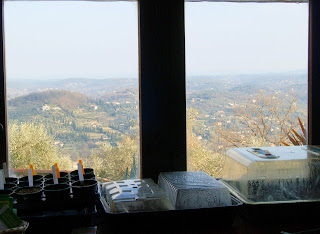It really has warmed up, and with the warmth other senses are awakened. Suddenly the garden is full of sound - birds singing their hearts out, the rustle of tiny lizards along sunny walls; and with the water finally turned back on there is the sudden rush of fountains too. It’s a bit like Narnia after the White Witch is defeated!
 However... there really is no time for mawkish fantasy - there are lots of very real, very manly jobs to be done. Like finding rocks, splitting them, hauling them across vertiginous garden slopes, driving them round the property in the pickup truck*, and mixing concrete. We’re laying paving in the new vegetable garden - the eventual idea is to pave the entire area between the beds, which keeps the amount of fiddly, difficult-to-maintain grass paths to a minimum.
However... there really is no time for mawkish fantasy - there are lots of very real, very manly jobs to be done. Like finding rocks, splitting them, hauling them across vertiginous garden slopes, driving them round the property in the pickup truck*, and mixing concrete. We’re laying paving in the new vegetable garden - the eventual idea is to pave the entire area between the beds, which keeps the amount of fiddly, difficult-to-maintain grass paths to a minimum. C, as our resident native Frenchman, has suggested calade, a traditional Provençal technique that involves placing pieces of local stone (here a warm honey-grey limestone) in a bed of sand and cement. Basically posh crazy paving. It’s not finished but it already looks wonderful - a statutory lesson in using local materials and matching them to the surroundings.
I did manage to escape and sow more early salads in the cold frame - rows of spinach, mesclun, oak-leaf lettuce, Early Nantes carrots, red mustard, rocket, mizuna... and the magnificent-sounding Radicchio ‘Palla Rossa Precoce’ - as cut and come again, bit of an experiment. It is described in the seeds of Italy catalogue as ‘tight compact redhead’ - sounds more like a person than a veg to me.
* another 'in at the deep end moment' - my first time driving the truck was reversing up three switchbacks with half a tonne of stone in the back.
* another 'in at the deep end moment' - my first time driving the truck was reversing up three switchbacks with half a tonne of stone in the back.


